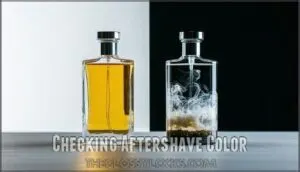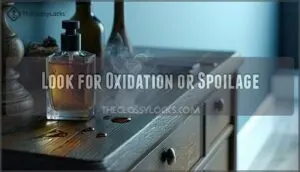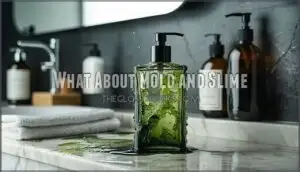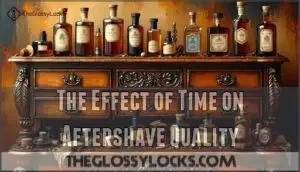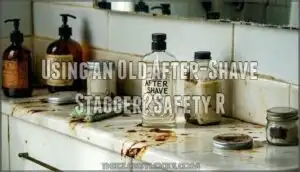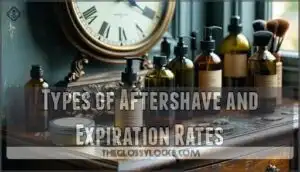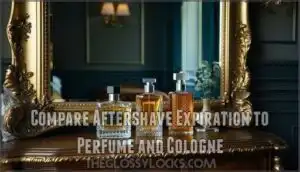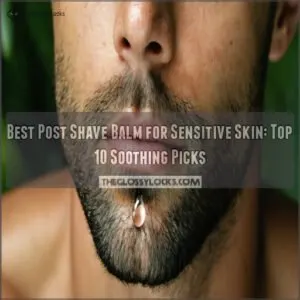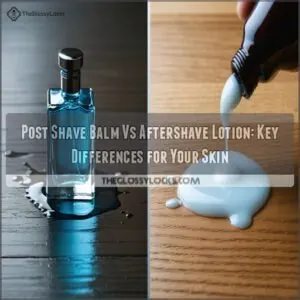This site is supported by our readers. We may earn a commission, at no cost to you, if you purchase through links.
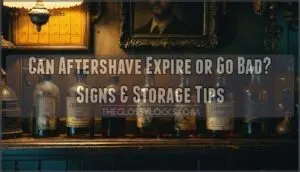
You’ll notice changes in scent, color, and texture as the alcohol evaporates and fragrance oils break down over time.
While expired aftershave won’t necessarily harm you, it loses its antiseptic properties and pleasant fragrance, potentially causing skin irritation.
The alcohol-based formula that once provided that invigorating post-shave sensation becomes less effective at preventing razor burn and bacterial growth.
Proper storage in cool, dark places helps extend shelf life, but even premium aftershaves aren’t immune to Father Time’s effects on their chemical composition.
Table Of Contents
- Key Takeaways
- Does Aftershave Expire?
- How to Tell if Aftershave is Expired
- The Effect of Time on Aftershave Quality
- Using an Old After-Shave Stagger?Safety R
- How to Store Aftershave to Prolong Shelf Life
- Types of Aftershave and Expiration Rates
- Compare Aftershave Expiration to Perfume and Cologne
- Frequently Asked Questions (FAQs)
- Do aftershave products expire?
- Do aftershaves go bad?
- How long do aftershaves last?
- How do I know if my aftershave has expired?
- Do aftershave & perfume go off over time?
- How long does a bottle of aftershave last?
- Is it okay to use expired aftershave?
- How to know if aftershave is expired?
- What is the shelf life of aftershave balm?
- Does aftershave last long?
- Conclusion
Key Takeaways
- You’ll notice expired aftershave through clear warning signs: sour or metallic scents, darkened or cloudy appearance, and texture changes that signal it’s time to replace your bottle.
- Your aftershave typically lasts 1-3 years depending on type – alcohol-based formulas maintain quality for 24-36 months while water-based versions expire in 12-18 months due to bacterial growth risks.
- You shouldn’t use expired aftershave because it loses antiseptic properties and can cause skin irritation, allergic reactions, or infections from harmful bacteria growth.
- You can extend your aftershave’s shelf life by storing it in cool, dark conditions away from heat and light, which prevents chemical breakdown and preserves effectiveness.
Does Aftershave Expire?
Yes, aftershave can expire and go bad, though it doesn’t come with a printed expiration date like food products.
Most aftershaves maintain their quality for 1-3 years when stored properly, but factors like ingredients, storage conditions, and whether the bottle’s been opened all affect how long yours will last, which can impact the overall shelf life.
What Happens When Aftershave Expires
When aftershave expires, several concerning changes occur that can affect both your skin and the product’s effectiveness.
Expired aftershave transforms from skincare ally to potential skin irritant through chemical breakdown.
Aftershave degradation happens through oxidation and chemical reactions that break down essential compounds. You’ll notice expired aftershave develops an off-putting, vinegar-like smell as fragrance molecules deteriorate. The color often darkens or becomes cloudy, signaling product spoilage.
Skin irritation becomes a real concern with expired products. Bacterial growth in compromised formulas can trigger redness, itching, or even infections—especially risky on freshly shaved skin. The aftershave shelf life varies, but degraded preservatives lose their protective power.
Here’s what typically happens when aftershave goes bad:
- Scent changes – Fresh fragrance turns sour or metallic
- Texture shifts – Liquid separates, thickens, or develops sediment
- Color alteration – Clear formulas become murky or discolored
- Reduced effectiveness – Lost antiseptic and moisturizing properties
Aftershave expiration isn’t just about poor performance—it’s a safety issue. Those chemical reactions create unpredictable compounds that your skin wasn’t meant to handle. Understanding aftershave longevity is vital to maintaining skin health and preventing irritation.
Differences Between Perfume and Aftershave Expiration
Looking at expired aftershave effects, you’ll notice key differences between perfume expiration and aftershave shelf life.
Perfume’s higher concentration and lower alcohol content creates different scent degradation patterns than aftershave.
Fragrance longevity varies substantially – perfume typically maintains quality for 1-3 years, while aftershave’s expiration dates depend more heavily on storage conditions and ingredient composition for ideal fragrance preservation.
Factors Affecting Aftershave Expiration
Multiple factors determine your aftershave’s shelf life beyond simple expiration dates.
Chemical reactions accelerate when storage conditions aren’t ideal, causing fragrance degradation and ingredient breakdown. Temperature fluctuations particularly impact aftershave spoilage rates.
Understanding the role of antiseptic agents is vital in maintaining aftershave effectiveness.
Key factors affecting aftershave expiration include:
- Ingredient quality: Natural oils and botanical extracts degrade faster than synthetic preservatives
- Storage conditions: Heat, light, and air exposure trigger oxidation and reduce shelf life substantially
- Chemical reactions: Alcohol content acts as a preservative, while water-based formulations spoil quicker
How to Tell if Aftershave is Expired
You can identify expired aftershave by checking for several clear warning signs that indicate the product has degraded beyond safe use.
Trust your senses—expired aftershave reveals itself through unmistakable changes in scent, color, and texture.
Look for changes in scent, color, texture, or any visible separation that signals the aftershave has gone bad, which are key indicators of degradation, particularly a change in texture.
Testing Aftershave Scent
Something’s definitely off when your aftershave’s scent testing reveals dramatic changes.
During fragrance analysis, notice if the aroma has shifted from fresh to sour or chemical-like.
Smell assessment should detect fading intensity or fragrance degradation.
Odor inspection helps identify aftershave expiration signs.
Compare against memory of the original fragrance.
Trust your nose’s aroma evaluation – compromised fragrance quality signals replacement time for ideal scent preservation.
Checking Aftershave Color
Beyond the scent test, visual inspection reveals critical aftershave expiration signs. Color change serves as your primary indicator—healthy aftershave maintains its original hue and clarity throughout its shelf life.
Watch for these visual expiration signs:
- Darkening or lightening from the original shade
- Murky or cloudy appearance instead of clear liquid
- Sediment formation at the bottle’s bottom
- Separation into distinct layers indicating ingredient breakdown
- Loss of transparency suggesting fragrance degradation factors
Compare your bottle against a fresh one when possible. These fragrance color changes signal chemical deterioration that compromises both safety and effectiveness.
Look for Oxidation or Spoilage
Watch for chemical reactions that signal oxidation and spoilage factors in your aftershave.
Cloudiness, darkening, or unusual texture changes indicate product degradation through chemical reactions.
Oxidation signs include metallic or vinegar-like odors replacing the original scent.
These changes mean your aftershave has gone bad and poses skin irritation risks, shortening its effective shelf life.
What About Mold and Slime
Mold Growth and Slime Formation represent serious Bacterial Contamination risks in expired aftershave.
You’ll spot fuzzy growths or slimy textures indicating Spoilage Signs. These Fungal Infections can cause skin irritation or infections.
Aftershave Contamination with Aftershave Bacteria makes the product unsafe. Aftershave Mold thrives in moisture-exposed bottles.
Don’t gamble with Expired Aftershave – discard contaminated products immediately. Understanding Aftershave Mold mold prevention methods is essential to maintaining product safety.
The Effect of Time on Aftershave Quality
Understanding how aftershave changes over time helps you determine when it’s time to replace your bottle.
Chemical reactions begin within the first month of opening, while most aftershaves maintain quality for six months to several years depending on their formulation.
After a Month – Common Chemical Reactions
Within the first month, your aftershave begins experiencing chemical breakdown as fragrance compounds interact with oxygen.
Oxidation rates accelerate ingredient instability, leading to subtle scent shifts and color changes.
These early chemical reactions signal the beginning of fragrance degradation, though your aftershave remains usable.
Common early signs include:
- Scent evolution – fragrance notes become more concentrated or muted
- Color darkening – clear liquids develop amber or yellow tints
- Texture changes – slight thickness variations from alcohol evaporation
Six-Month and Longer Durability Rates
Most aftershave products maintain their shelf life well beyond six months when stored properly. Aftershave longevity depends on formulation and storage tips you follow. Aftershave expiration typically occurs between two to five years, though product longevity varies by type and conditions.
Aftershave freshness indicators include:
- Fragrance stability remains intact for alcohol-based formulas lasting 5+ years
- Aftershave duration decreases faster in balms containing water and oils
- Aftershave shelflife extends substantially with consistent cool, dark storage
Understanding the best aftershave products is vital for maintaining skin health and preventing irritation.
Using an Old After-Shave Stagger?Safety R
Testing old aftershave isn’t worth the risk. Expired aftershave can trigger skin irritation and allergic reactions, especially if bacterial growth has occurred.
Before applying questionable aftershave, perform a patch test on your wrist—wait 24 hours for reactions.
| Risk Level | Symptoms |
|---|---|
| Low | Mild redness, slight burning |
| Moderate | Rash, itching, swelling |
| High | Severe irritation, blistering |
| Critical | Allergic reaction, infection |
When aftershave expiration occurs, chemical breakdown creates compounds that harm skin. Aftershave safety depends on proper shelf life management—don’t gamble with your face.
Proper shaving preparation techniques, such as those found in skin care routines, can help minimize the risk of irritation and guarantee a smooth shaving experience.
How to Store Aftershave to Prolong Shelf Life
You can substantially extend your aftershave’s shelf life by storing it properly in cool, dark conditions.
The key factors are temperature control and light protection, which prevent chemical breakdown and preserve the product’s effectiveness.
Cooler or Cooler Storage
Beyond safety concerns, proper cool storage and temperature control substantially extend aftershave lifespan. Store bottles at 45-55°F using a dedicated mini fridge or wine cooler—not your food refrigerator. This controlled environment slows chemical reactions and prevents humidity levels from compromising quality. Dark bottles protect contents better than clear ones.
- Your aftershave deserves VIP treatment—give it a climate-controlled sanctuary
- Cool storage can extend freshness by 1-2 years beyond typical shelf life
- Temperature shocks from frequent moves damage fragrance storage integrity
- Dedicated cosmetic storage prevents contamination and maintains potency
For ideal organization, consider investing in a dedicated Aftershave Storage solution.
How Dark Affects Storage
Light exposure degrades aftershave ingredients through UV radiation, causing chemical breakdown and scent deterioration. Store your aftershave in dark storage locations to maximize shelf life and maintain fragrance integrity. Light protection prevents oxidation and preserves quality.
Using the right skin care products is vital for maintaining healthy skin.
Essential storage tips for effective fragrance storage:
- Use dark-tinted bottles or wrap clear containers in paper
- Store in cool places like cupboards away from windows
- Avoid bathroom storage due to light exposure and humidity
- Keep bottles in original packaging for maximum protection
Types of Aftershave and Expiration Rates
Different types of aftershave have varying shelf lives based on their formulation and ingredients.
Alcohol-based splashes typically last 24-36 months, while water-based balms and gels expire faster at 12-18 months due to higher bacterial growth risk, which affects their overall shelf life.
Balmy, Gels, Splashes, Colognes, and More
Understanding Aftershave Types helps you predict Shelf Life accurately.
Each variation has distinct expiration patterns based on formulation. Balms last 2-3 years but spoil faster due to oils. Splashes with alcohol preserve longest at 3-5 years. Gels expire within 1-3 years depending on preservatives.
Knowing the different Aftershave types is essential for maintaining skin health.
| Type | Shelf Life | Key Factor |
|---|---|---|
| Balms | 2-3 years | Water/oil content |
| Gels | 1-3 years | Preservative levels |
| Splashes | 3-5 years | Alcohol concentration |
| Colognes | 3-5 years | Base note composition |
Factors Affecting Type Specific Lifespan
Your aftershave’s lifespan depends on several key factors that you can’t ignore. Alcohol content acts as a natural preservative, with higher concentrations extending shelf life substantially. Water-based formulas degrade faster due to microbial growth potential, while synthetic ingredients outlast natural botanicals.
Consider these Shelf Life Factors:
- Ingredient Impact: Natural oils oxidize quicker than synthetic compounds
- Storage Conditions: Heat and light accelerate Chemical Reactions and fragrance expiration
- Product Variations: Aftershave ingredients determine preservation effectiveness and overall durability
The cost of aftershave is influenced by factors such as rare natural ingredients.
Compare Aftershave Expiration to Perfume and Cologne
When you’re choosing between aftershave, perfume, and cologne, understanding their fragrance expiration patterns helps you make smarter purchasing decisions.
Each product type offers different scent longevity and aftershave stability characteristics that directly impact your investment.
Product Shelf Life Storage Tips
Perfume’s higher fragrance concentration (15-25%) creates better cologne durability compared to aftershave’s 1-3% oil content.
This fragrance comparison reveals why your perfume shelf life extends substantially beyond aftershave expiration timelines.
The alcohol content in each product acts as a natural preservative, but aftershave’s water-based formulas make it more vulnerable to bacterial contamination.
Your fragrance shelf life depends heavily on proper storage conditions and ingredient quality, regardless of product type.
Frequently Asked Questions (FAQs)
Do aftershave products expire?
Yes, aftershave products do expire and can go bad.
You’ll notice changes in scent, color, or texture when they’ve degraded.
Alcohol-based varieties last longer than water-based ones, typically staying fresh for two to three years when stored properly, which is a key factor in their longer shelf life.
Do aftershaves go bad?
Yes, aftershave products can deteriorate over time.
You’ll notice changes in scent, color, or texture indicating spoilage.
Alcohol-based versions last longer than water-based ones, typically maintaining quality for one to three years when stored properly.
How long do aftershaves last?
Most aftershaves last 1-3 years, depending on their ingredients and storage conditions.
Alcohol-based versions typically maintain effectiveness for 24-36 months, while water-based formulas expire sooner at 12-18 months due to bacterial growth risks.
How do I know if my aftershave has expired?
Check your aftershave by examining its scent, color, and texture. If it smells sour, looks cloudy or darker, feels different, or causes skin irritation, it’s expired and should be discarded.
Do aftershave & perfume go off over time?
Like milk left on the counter, fragrance molecules break down when exposed to heat and light.
Yes, both aftershave and perfume degrade over time, losing potency and developing off-odors through oxidation and chemical breakdown.
How long does a bottle of aftershave last?
A bottle of aftershave typically lasts 1-3 years, depending on ingredients and storage conditions.
Alcohol-based formulas last longest at 24-36 months, while water-based versions expire in 12-18 months due to bacterial growth potential.
Is it okay to use expired aftershave?
Using expired aftershave is like playing with fire—it can backfire.
You shouldn’t use expired aftershave because it may cause skin irritation, allergic reactions, or harbor harmful bacteria that compromise your safety.
How to know if aftershave is expired?
You’ll spot expired aftershave through obvious changes: faded or sour scent, color shifts, cloudiness, separation, altered texture, or skin irritation after use.
What is the shelf life of aftershave balm?
Aftershave balm typically lasts 18-24 months once opened, though unopened products can remain effective for 3-5 years when stored properly in cool, dark conditions away from heat and humidity.
Does aftershave last long?
Most aftershave products last 1-3 years when stored properly. Alcohol-based versions typically maintain their effectiveness for 24-36 months, while water-based formulations last 12-18 months due to increased bacterial growth risk.
Conclusion
Remember this: you can’t always see when aftershave expires, but you can definitely feel its effects.
You’ll notice changes in scent intensity and color variations before complete deterioration occurs.
So can aftershave expire or go bad? Absolutely – and recognizing the signs protects your skin from irritation while ensuring ideal post-shave care.
Store your aftershave properly in cool, dark conditions to maximize its lifespan and maintain its therapeutic benefits for years to come.


